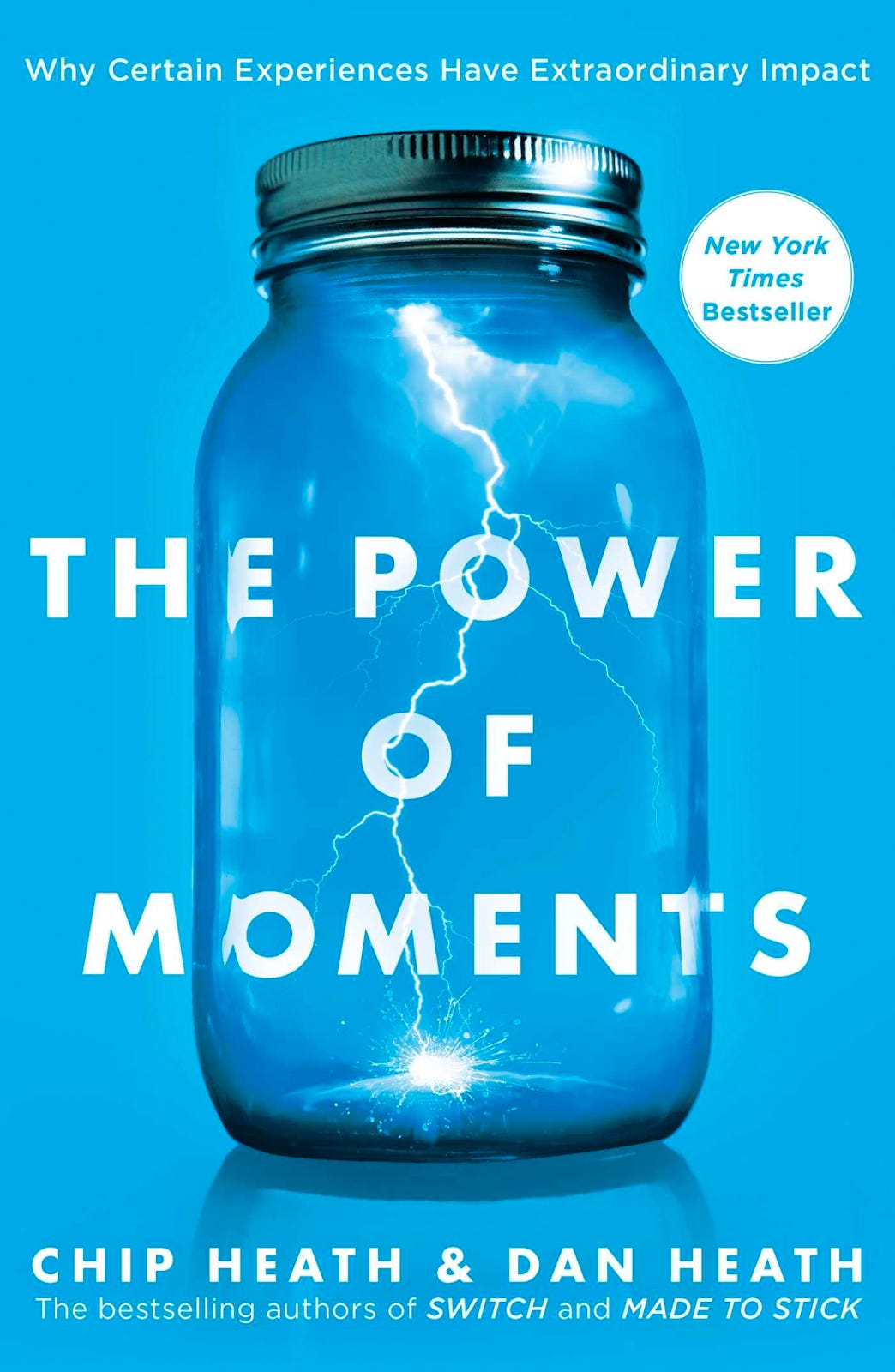Don’t Violate Expectations Without a Strategy - Dan Heath’s Bonkers DormShowerCam.com Story
An Unexpected Lesson in Earning Attention
Welcome to the Creativity Business, a newsletter about how to Earn Attention as a marketer or content creator. If you’re not a subscriber, sign up and get content strategy delivered to your inbox every two weeks for free.
I’ve been fortunate to get to know Dan Heath through some podcasting projects over the years and was thrilled that he was open to having a discussion about how to apply the ideas from Made To Stick and The Power of Moments (two of the best-selling books he wrote with his brother, Chip), to the concept of Earning Attention. I learned a ton talking with Dan - you’ll see bolded quotes from Dan throughout the newsletter that stood out to me.
The Power of Unexpectedness
Before we get to the DormShowerCam.com story, we need to talk about two key concepts from Dan’s work: Unexpectedness and Violating Expectations. I asked Dan for his thoughts about the overlap between Earning Attention and creating sticky ideas and he immediately honed in on this one particular area.
“Sticky ideas are effective partly because of their ability to capture and hold the attention of the audience. For messages to stick, they need six traits (or as many of the six as you can muster).
Simplicity
Unexpectedness
Concreteness
Credibility
Emotion
Story
The one that applies to attention is Unexpectedness.”
When we encounter something unexpected, we pay attention precisely because it does not fit with our mental model of how things are supposed to work. If one of our brain’s key jobs is to order the world and create predictability for our own safety and success, something unexpected very quickly earns our full attention. And when you have someone’s full attention, you have the opportunity to create change and impact. I am a passionate advocate for Unexpectedness as a value in creating content, especially when it comes from brands. (I recently wrote about Unexpectedness as a key ingredient in Slack’s podcast success.)
Violating Expectations to Create Peak Moments
Unexpectedness isn’t just a powerful value for ideas, though - it’s also essential for crafting memorable experiences.
“If you look at the way people remember their experiences, their memories tend to hinge on certain peak moments.
So if you look back on your college experience or a vacation from five years ago, or a trip to Disney World, most of your experience just dissolves over time. But you're left with certain moments that do endure. And those moments share certain characteristics. If we're thoughtful about it, we can create memorable, peak moments as the anchors of the experiences that we care about.
So to Earn Attention with Moments - it relates to something we call breaking the script. If you really want to amp up a moment, there's gotta be something about it that violates your expectations.
We shared one example in the book about a corporate team that thought they were all heading to a standard corporate meeting. PowerPoints, executive speeches, and so on. Instead, they're dismissed from the ballroom after 15 minutes and put on buses and they go out to do all these crazy activities. So something like that totally blows up your schema of what's going to happen at a corporate meeting. By surprising you, by violating your expectations, they've stamped the memory more emphatically in your brain.”
The Threshold of Unexpectedness
Creating Sticky Ideas, Peak Moments and Earning Attention are not exactly the same, but there clearly is a heavy zone of overlap.
“If you look at the Venn diagram, the point of intersection is breaking a pattern. You can break a pattern with a message, you can break a pattern with a moment.”
Breaking patterns can take many forms. With content from brands, the common expectation is that it is a thinly disguised, manipulative infomercial or sales pitch. In my experience, breaking this pattern and Earning Attention can be as simple as producing audience-first content that is good.
In this context, I asked Dan whether more brands should consider audience-first content instead of talking about themselves, their products, and their services. I’ve known for a while that some of the outcomes of an audience-first strategy are a more favorable brand perception and increased time and engagement with the brand, but Dan added an additional level of business insight that I had not considered before.
“Should companies go beyond talking explicitly about their products and instead try to use insights as a way of deepening relationships with their customers? For example, instead of talking about Clorox Wipes, Clorox could make videos about the best way to sanitize a bathroom. It could be really powerful because the act of having to figure out what's useful to your customers in order to get them interested in their videos will make you better at what you do. It almost has to, right?
If you can understand people's challenges by coming up with videos they love, surely that's gonna create epiphanies about other products or other product attributes or what have you. There is a kind of strategic flywheel there.”
So with the right approach, creating value for audiences with content can create even more value for the brand producing it. However, Dan has a splash of cold water for overzealous optimists like me.
“In the real world, though, nine out of ten times, it's just going to be the viral marketing team playing on the memes of the month to get views … an advertising flavor-of-the-month campaign snapped onto a company and a product engine that are hermetically sealed away from the customer insights.”
And, of course, Dan is right. This again makes the concept of creating generous, audience-first content even more radical - and this approach is indeed often enough to Earn Attention. The flavor-of-the-month club approach Dan brings up led to another topic I am passionate about - short-term thinking vs long-term thinking with content strategy.
Short-term vs Long-term Content Strategy
“Effectiveness in the long-term is largely a function of how well you empathize with the people you're trying to reach and how much value you provide. That sounds like, ‘Well, duh!’ But it's not the norm.
A lot of the things that we measure with content or marketing are short-term metrics. They're Opens and Clicks and Views and none of those things really speak to whether the audience learned how to sanitize the bathroom better from that video.
The same thing is true with the books that Chip and I write. We never come out of the gate and sell a hundred million copies. Our books kind of trot out of the gate instead of charging out of the gate. But they just keep trotting, and they may keep trotting for fifteen years, which is very different than the decay rates of most books.
We really do care about providing value and almost none of our books are topical or of the moment. Most of the material, we hope, is just as useful years later as it was the day it was written. And that's with intention. We're trying to think like the reader, we're trying to put ourselves in their shoes and, and to arm them with what they need to make change.”
The DormShowerCam.com Debacle - Sticky Needs to be Tied to Strategy
So how does all this - Unexpectedness, Violating Expectations, Short-term vs Long-term thinking - finally lead up to the shocking story of DormShowerCam.com and WHY IS DAN HEATH INVOLVED IN IT???
Well, dear newsletter reader, it is time for Dan to tie everything together with a very nice bow… and a powerful lesson.
“Back in the day, the dot com era, I co-founded a startup called Thinkwell, an education company. Our first product was a kind of study guide that was intended to help college students study better for courses like calculus and economics.
We needed a way to get the attention of college students and we needed to get them to try out this new service. So we hired one of the hottest ad agencies in town.
We do all this work on the design brief, and it finally comes time for them to pitch some campaigns. They bring out these mockups that are intended to be a postcard mailer. The idea is that it shows up in your dorm mailbox, and it's this mysterious-looking postcard.
It's all black with just a URL on the cover in large letters. No other copy whatsoever. And the URL is… DormShowerCam.com.
Having shown us the postcard, they take us over to the computer and plug in the URL and then this video launches - you're looking from the top of a shower down on this young woman. And she looks up directly at the camera and says, ‘Why are you watching me take a shower when you should be studying for calculus?’
And then the site redirects to Thinkwell.
That's crazy! And there were just crickets in the room at that moment.
And I'll never forget that moment because the expression on the ad guys’ faces was, ‘We are the cleverest S.O.B.s that ever lived. We’ve cooked up a multimedia campaign with narrative aspects. It provokes emotion. There's going to be viral word-of-mouth - we're going to be the talk of the town at the next advertising conference.’ It's almost like they couldn’t wait to show this to their buddies in advertising to demonstrate how cutting-edge they were.
To me, that's a fabulous example of squandered surprise. Surprise can do work for you by gaining the attention of your audience. But then what? What will you do with that attention? You need an organic link between surprise and strategy.
There were multiple independent reasons why this campaign was a travesty. Let’s start with the most obvious one: It was a moral travesty and possibly a legal one as well. I mean, in today’s world, the agency leaders would be run out of town for that idea, but even 25 years ago, it was pretty skeezy.
The amazing thing is that this was a campaign that literally worked for no one. No one. Even if you somehow wave away the moral issues, then still you’re left with a campaign that is immediately off-putting to 95% of the market, including 100% of women. And let’s say there are 5% that ARE interested – you’ve got their attention alright. So they go to the URL and you redirect them to a CALCULUS STUDY GUIDE? I mean, do we think this is a good conversion strategy??
There are so many layers on which this was a terrible campaign. It's just stuck with me as a lesson that the real art of communication is to align attention and curiosity with strategy. One can't really exist without the other.”
It goes without saying that Dan and the Thinkwell team thoroughly rejected this gross campaign idea. It’s an extreme example of taking principles like Violating Expectations too far, and without a strategic end goal in mind. And even though it makes my skin crawl that anyone ever thought this might be a good idea, the Unexpectedness of this story itself bakes in the lesson very, very effectively.
Also, with this final insight, Dan has captured the essence of what this newsletter is about - the careful balancing of Creativity and Business to achieve the double win of happy, engaged audiences on one side, and desired business outcomes on the other.
Unexpectedness and Violating Expectations that aren’t aligned with your business goals are a waste of everyone’s time and money. And boring, self-centered business content without Unexpectedness will be ignored by those you seek to reach.
Takeaways
Are you strategically thinking about Unexpectedness and Violating Expectations when you have an idea, message or experience to create?
Are you focused on the long-term win of creating value for others that in turn creates brand value or drives business insights? Or are you in the flavor-of-the-month meme club?
If you’re applying principles for Making Ideas Stick, engineering Peak Moments, or Earning Attention, are they aligned with your strategic end goals?
If you want to learn more about Dan and Chip’s ideas, you can find all their books on their website.
What’s Earned My Attention Recently
Your Strategy Needs A Story
Approaching it from the other side of the equation - HBR on the power of story to make a strategy effective.
35 Ways Real People Are Using A.I. Right Now
This is a fascinating array of everyday uses of A.I. - the scope and scale of the applications continue to boggle the mind.
A.I. Generated a Track Featuring A.I. Drake and A.I. Weeknd
On the flip side, it feels like every week, A.I. brings new existential dread to the creative industries. In this week’s edition, conjuring a collaboration that never happened to produce a song humans didn’t write.
Bonus Content!
Finaly, big thanks to Mike Steadman at Ironbound Media for having me on his podcast to talk about giving brands a voice and building successful shows as a brand.
I am such a big fan of laser-focused businesses and Mike is an amazing example - he specializes in working with veteran-owned businesses and veteran entrepreneurs and his passion and expertise are on full display!
Giving Brands A Voice with Steve Pratt, Founder of the Creativity Business
If you’re a brand looking to earn more attention, or a creative services company wanting to differentiate and grow your business, please check out the Creativity Business website.










